As Beijing prepares for the 2008 Summer Olympics, common courtesies are the focus of attention. For example, spitting. One cannot walk down the street without hearing a raucous hawking from the throat, then a well-aimed projectile of spit which goes, hopefully, away from any moving object, like me. Now spitting and its aftermath are not unknown to me. I remember signs all over New York warning against the consequences of spitting, like fines. Ha! These prohibitions probably started at the beginning of the twentieth century and to my knowledge the habits were never really eradicated. Yes, we eliminated the use of spittoons and few people are in the habit of openly chewing tobacco. Nevertheless, I remember seeing spittle almost everywhere I looked on the streets of New York when I worked there. It was particularly evident in the winter when one would see dripping spittle frozen in place on the steps as one ascended from the subway. Also, you don't always see the spittle, but you definitely see the spitting, if you are tuned into watching an American baseball game. Invariably, the camera will pan to the dugout and at that moment a beloved player will let go and spit right in front of the viewer. I've often wondered who has the unenviable job of cleaning up the dugout of all that spittle after the game.
Anyway, back to China. It seems the government is having a campaign to get people (I've only observed men engaging in this disgusting habit) to be more subtle in their spitting. For example, Zhang Huigang, director of the Capital Ethics Development Office, has at her disposable $2.5 million which she will use to distribute spit-bags and to hire 1,500 bus-riding supervisors to enforce good behavior.
Oh yeah, did I mention the rudeness of people riding the buses and subways? They force their way into a crowded subway car or bus without giving way to those about to exit. Of course, I've never seen this happen in any other mass transit metropolis, except San Francisco, Chicago, Boston, New York, Los Angeles and London.
Here, they don't offer their seats to "old" people, in fact, they pretend not to see them. I've found this ploy does not work with me. I just stare them down until guilt takes over and they offer their seat not only to a "foreigner" but an "old" one at that! Courtesy may be taking hold right here in Beijing and I'm on a one woman campaign to make it happen. I have to admit that I had two exemplary role models, my mother, Kay Kromer and Bob's mother, Sue Emrich!
In an effort to "overhaul their etiquette in time for the 2008 Olympics, the Beijing Spiritual Civilization Construction office's "A General Textbook on Civility and Propriety" was put together by a team of experts on 'civility and propriety.' It has been delivered to more than 4.3 million families in Beijing."
(Quoted from City Weekend Beijing Entertainment Guide, In China, by Adam Skuse.)
Should make for some good bedtime reading!
I have not yet seen any campaign against smoking in public places. Being from California, I am shocked, I tell you shocked, at the amount of smoking that goes on in restaurants, offices and other public areas of Beijing. (Again, I rarely see women smoking). Something must be done. I'm thinking of launching a campaign to make this a bell weather city of China. No more spitting, smoking or being rude to "old" people. Who knows, it could set a trend for the rest of the country, like California did for the U.S.A.
Thursday, November 30, 2006
Monday, November 27, 2006
A Day in the Life . . .
It's been getting colder here but so far not unbearable. Today was sunny and in the forties. We've had some beautiful weather in October and November. I understand Beijing doesn't get much precipitation. The last time we had a heavy rain was a week or so after I came here. There's been some drizzle but not much else. Friends have asked if I've been lonely at all. Truth be told, I haven't. There always seems to be something to do. Either teaching or going sightseeing or shopping. If I'm bored I can always go for a nice foot massage!
One of the things I love about living in a city is that there is always something to do and usually within walking distance (or as you're probably learning by now -- a short taxi ride). Most people who know me also know I love to read and, as television in English is non-existent, I read a lot. I've also purchased some DVDs to keep me entertained. I talk to Bob at least once a day, sometimes twice, thanks to Skype. Then, of course, there are always the mundane tasks like laundry, cleaning and cooking.
In many ways, it has been like a vacation here. I've taken a lot of tours in and around Beijing with the Chinese Culture Club which is a private club that caters to ex-pats and tourists, most of which you've probably read about on my blog (the tours I mean, not the tourists). I've seen all five UNESCO World Heritage Sites in the Beijing area - The Great Wall, the Forbidden City, the Temple of Heaven, the Summer Palace, and the Peking Man site.
Bob will be visiting for 11 days at Christmas time. We will take a trip on the Yangtze River for 4 days and will visit Xien (terracotta warriors) for 2 days. Bob will also have 4 days of sightseeing in Beijing. He leaves Jan 1 and that will be just about my half-way mark in Beijing. I have a friend who's thinking of visiting me in January or February for a couple of weeks. I also will probably take one or two weekend trips before I leave China.
The Chinese have a great respect for their elders. Almost too much so. It's nice when you're offered a seat on the subway. However, I've also had some remarks made which have given me pause. One was from a young man in my English Corner class who was impressed that I was wearing earrings and dressed fashionably (for China). He said most "old" people in China don't dress that way and aren't active like I am. The other comment was from the community group leaders who were overly concerned that I would become "fatigued" if I stood up for more than five minutes. Now, I've tried to get away with this act with Bob but it's never been a go.
People in China are required to retire at a certain age. Women are encouraged to retire at about 55 and men at about 60. The older people I observe mostly dress in conservative clothing. Many of the grandparents are taking care of the grandchildren while the parents work. There seems to be some effort in getting retired people interested and involved in programs that they didn't have time for when they were younger, like art and calligraphy. I often see older people on group tours. Also, I'm told, many will go to the park early in the morning to exercise. As I am not a morning person, I cannot testify to this but when Bob is here I will send him out to get verification.
It is a nation of young people and in Beijing many of them have disposable income. I see them in the shopping malls and walking around the various neighborhoods. Many are very fashionably dressed and the young women, in particular, wear the cutest clothes. Now that winter is almost here, boots, coats, hats and scarves are being worn all to great effect. A growing concern in China, is the disparity between the growing affluent population in the cities and the poorer rural areas. How this problem will be played out remains to be seen.
One of the things I love about living in a city is that there is always something to do and usually within walking distance (or as you're probably learning by now -- a short taxi ride). Most people who know me also know I love to read and, as television in English is non-existent, I read a lot. I've also purchased some DVDs to keep me entertained. I talk to Bob at least once a day, sometimes twice, thanks to Skype. Then, of course, there are always the mundane tasks like laundry, cleaning and cooking.
In many ways, it has been like a vacation here. I've taken a lot of tours in and around Beijing with the Chinese Culture Club which is a private club that caters to ex-pats and tourists, most of which you've probably read about on my blog (the tours I mean, not the tourists). I've seen all five UNESCO World Heritage Sites in the Beijing area - The Great Wall, the Forbidden City, the Temple of Heaven, the Summer Palace, and the Peking Man site.
Bob will be visiting for 11 days at Christmas time. We will take a trip on the Yangtze River for 4 days and will visit Xien (terracotta warriors) for 2 days. Bob will also have 4 days of sightseeing in Beijing. He leaves Jan 1 and that will be just about my half-way mark in Beijing. I have a friend who's thinking of visiting me in January or February for a couple of weeks. I also will probably take one or two weekend trips before I leave China.
The Chinese have a great respect for their elders. Almost too much so. It's nice when you're offered a seat on the subway. However, I've also had some remarks made which have given me pause. One was from a young man in my English Corner class who was impressed that I was wearing earrings and dressed fashionably (for China). He said most "old" people in China don't dress that way and aren't active like I am. The other comment was from the community group leaders who were overly concerned that I would become "fatigued" if I stood up for more than five minutes. Now, I've tried to get away with this act with Bob but it's never been a go.
People in China are required to retire at a certain age. Women are encouraged to retire at about 55 and men at about 60. The older people I observe mostly dress in conservative clothing. Many of the grandparents are taking care of the grandchildren while the parents work. There seems to be some effort in getting retired people interested and involved in programs that they didn't have time for when they were younger, like art and calligraphy. I often see older people on group tours. Also, I'm told, many will go to the park early in the morning to exercise. As I am not a morning person, I cannot testify to this but when Bob is here I will send him out to get verification.
It is a nation of young people and in Beijing many of them have disposable income. I see them in the shopping malls and walking around the various neighborhoods. Many are very fashionably dressed and the young women, in particular, wear the cutest clothes. Now that winter is almost here, boots, coats, hats and scarves are being worn all to great effect. A growing concern in China, is the disparity between the growing affluent population in the cities and the poorer rural areas. How this problem will be played out remains to be seen.
Tuesday, November 21, 2006
Modes of Transportation
 People have asked how I get around Beijing. Well, my main mode of transportation is taxi or feet. Feet are a lot cheaper. But cheap is relative. Most trips in a taxi cost between 10 and 20 yuan, $1.25 to $2.50 per trip. Most Beijingers wouldn't even consider a taxi trip. They travel by bicycle ($.00), bus (1 yuan) ($.12), subway (3 yuan)($.37)or feet ($.00). With taxis, I use the map which has English or Chinese characters for the destinations. I also have cards with specific destinations like the Y, my home, or nearby shopping districts written in Chinese characters. Often the taxi drivers don't understand where I wish to go. I have now developed to where I can direct them to a certain extent. Left, Right, Straight Ahead, Stop. If I want to venture beyond familiar territory, it's every woman (or man) to herself (himself). We do a lot of gesturing and nodding. Then I cross my fingers and hope we get near to my destination. The taxi drivers seem to like when I use my terribly bad Chinese pronounciation to give directions. They laugh and correct my Chinese. You can pretty much get by if you can say hello (Nee How), thank you (Xie, Xie) and okay (Okay). Smiles help! They seem to like "Bye-Bye" which can be a relief to both of us. As long as I get to where I want to go, I'll play the fool! So far I have managed to naviagate the city pretty well. With about 67,000 taxis, I don't imagine I'll have the same driver twice. I've only been here for 7 weeks and I'm still getting my bearings. In the last two days, I've learned of some places that are within walking distance of my apartment, like Tiananmen Square (a very long walk) and some shopping districts. Of course, now the weather is getting colder so who knows how much walking I'll be doing in the name of research!
People have asked how I get around Beijing. Well, my main mode of transportation is taxi or feet. Feet are a lot cheaper. But cheap is relative. Most trips in a taxi cost between 10 and 20 yuan, $1.25 to $2.50 per trip. Most Beijingers wouldn't even consider a taxi trip. They travel by bicycle ($.00), bus (1 yuan) ($.12), subway (3 yuan)($.37)or feet ($.00). With taxis, I use the map which has English or Chinese characters for the destinations. I also have cards with specific destinations like the Y, my home, or nearby shopping districts written in Chinese characters. Often the taxi drivers don't understand where I wish to go. I have now developed to where I can direct them to a certain extent. Left, Right, Straight Ahead, Stop. If I want to venture beyond familiar territory, it's every woman (or man) to herself (himself). We do a lot of gesturing and nodding. Then I cross my fingers and hope we get near to my destination. The taxi drivers seem to like when I use my terribly bad Chinese pronounciation to give directions. They laugh and correct my Chinese. You can pretty much get by if you can say hello (Nee How), thank you (Xie, Xie) and okay (Okay). Smiles help! They seem to like "Bye-Bye" which can be a relief to both of us. As long as I get to where I want to go, I'll play the fool! So far I have managed to naviagate the city pretty well. With about 67,000 taxis, I don't imagine I'll have the same driver twice. I've only been here for 7 weeks and I'm still getting my bearings. In the last two days, I've learned of some places that are within walking distance of my apartment, like Tiananmen Square (a very long walk) and some shopping districts. Of course, now the weather is getting colder so who knows how much walking I'll be doing in the name of research! I much prefer the subway. It's cheap but doesn't always get you near to your destination. Then it's subway and taxi which can be a challenge. But hey, I'm always up to a challenge. Buses are very crowded and not my primary choice. In fact, I avoid them as much as possible.
I much prefer the subway. It's cheap but doesn't always get you near to your destination. Then it's subway and taxi which can be a challenge. But hey, I'm always up to a challenge. Buses are very crowded and not my primary choice. In fact, I avoid them as much as possible. .
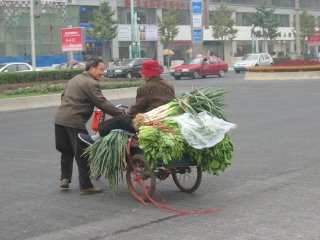
Here you can see papa moving mama and lunch on their bicycle apparatus.
 Of course, in the country you see more simple forms of transportation.
Of course, in the country you see more simple forms of transportation.
Welcome to Alexander Charles
 A real highlight has been the arrival of my seventh grandchild, Alexander Charles, on November 18th weighing in at 7 lbs and 19 inches. I'm sorry I wasn't there in person but Alexander has a lot of sleeping to catch up on so I think he'll understand. This is Cheryl and Glenn's second child and a joyful birth it is! Although Cheryl did all the work, for my part I was able to be in touch with the joyful happenings through the miracles of technology. We have e-mail and Skype to keep up to date with what's current. Aiden is the proud big brother. I'm looking forward to their sibling bonding in the future!!
A real highlight has been the arrival of my seventh grandchild, Alexander Charles, on November 18th weighing in at 7 lbs and 19 inches. I'm sorry I wasn't there in person but Alexander has a lot of sleeping to catch up on so I think he'll understand. This is Cheryl and Glenn's second child and a joyful birth it is! Although Cheryl did all the work, for my part I was able to be in touch with the joyful happenings through the miracles of technology. We have e-mail and Skype to keep up to date with what's current. Aiden is the proud big brother. I'm looking forward to their sibling bonding in the future!!
Monday, November 20, 2006
FaYuan Temple
 This temple was originally built more than 1300 years ago during the Tang Dynasty. It was built by Emperor Taizong as a memorial for soldiers in a war. The incense burners pictured are at the entrance to the first temple. Incense is used to purify the mind before going into the temple. Our guide was a practicing Buddhist and he explained many of the symbols in a quiet and peaceful manner. For example, a knot symbolizes endlessness and also that the Buddha can help us untie the knot within us; the wheel symbolizes getting rid of suffering through Dharma; the conch shell, which can be blown like a horn, spreads Buddha's teaching far away; the lotus flower symbolizes purification; and the vase contains the dew of widom -- to drink of it means you learn; fish symbolize life -- when it mets with water it becomes alive. He explained, the Chinese culture and values are built on Confuscianism, Taoism, Buddhism and materialism. In Buddhism, there are four all-embracing virtues -- giving, kind words, kind doings, equality. Also there are four noble truths -- suffering, arising of suffering, cessation of suffering, the way to cessation of suffering. And there is the Noble Eightfold Path -- right view, right thinking, right mindfulness, right speech, right action, right diligence, right concentration, right livelihood.
This temple was originally built more than 1300 years ago during the Tang Dynasty. It was built by Emperor Taizong as a memorial for soldiers in a war. The incense burners pictured are at the entrance to the first temple. Incense is used to purify the mind before going into the temple. Our guide was a practicing Buddhist and he explained many of the symbols in a quiet and peaceful manner. For example, a knot symbolizes endlessness and also that the Buddha can help us untie the knot within us; the wheel symbolizes getting rid of suffering through Dharma; the conch shell, which can be blown like a horn, spreads Buddha's teaching far away; the lotus flower symbolizes purification; and the vase contains the dew of widom -- to drink of it means you learn; fish symbolize life -- when it mets with water it becomes alive. He explained, the Chinese culture and values are built on Confuscianism, Taoism, Buddhism and materialism. In Buddhism, there are four all-embracing virtues -- giving, kind words, kind doings, equality. Also there are four noble truths -- suffering, arising of suffering, cessation of suffering, the way to cessation of suffering. And there is the Noble Eightfold Path -- right view, right thinking, right mindfulness, right speech, right action, right diligence, right concentration, right livelihood. The temple also is a monastery and religous school. It is a complex of many buildings with smaller temples leading to the main temple of the reclining Buddha. There are study halls, a dining room, a Zen room for meditation, etc. About 100 monks and students live in the complex.


Here you can see an inner courtyard with the round opening leading to the main temple. The people are looking at literature for a special holiday which will take place soon.


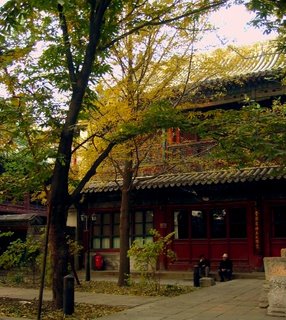
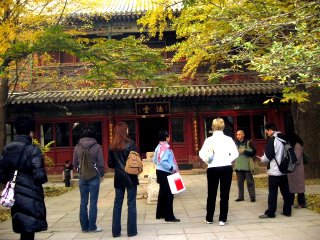
The late afternoon autumn sunshine lit up the temple and the trees. Flowers were in place for the special holiday. Our guide had us become aware of the flowers as symbolizing the cycle of life, from seed to full bloom to dying off and then returning to the earth. This is the kind of thing a Buddhist would meditate on to lose himself in the contemplation of the flower.

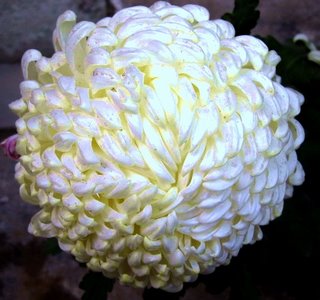
As we were finishing our tour, a young man went about the complex pounding a wooden plaque, calling the monks to prayer. We quietly stood in the courtyard as we listened to the monks chanting their mantras and sutras.
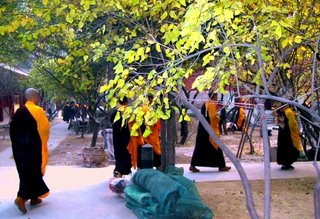

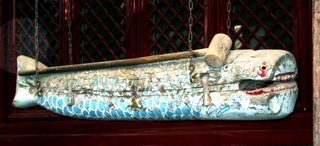
Sunday, November 19, 2006
You Are What You Eat?
If it's true, "You Are What You Eat", I am probably part donkey, part shrimp and part pig with a little bit of hot pepper thrown in! I'm not the biggest fan of Chinese food but I must admit that in Beijing, I've had some of the best Chinese food ever. The other night I went out with some tourists and I have to say it's embarrassing. They wanted wanton soup and food with no spices. Now in Beijing, it's not hard to get bland food. Noodles and dumplings are a mainstay here. But in the restaurant we were at, the food tended to be a little more exotic. There were duck tongues, duck bills, webbed feet and some kind of stomach of something. I passed on these. However, we had some very interesting dishes also. There was a sparerib dish with the ribs cut very small and served in a savory sauce inside a steamed pumpkin. Delicious! We also had shrimp with peppers and mushrooms, dumplings and a delicious soup. I didn't take pictures of these dishes as we were with "tourists" and I didn't want to look like a tourist. Oh well, I'm sorry I missed out on the opportunity to do so. On Monday, Chinese friends, Laura and Hunter, took me to a famous noodle restuarant and it was very nice. We had spareribs and noodles. As you can see, I enjoyed them very much!



What do I eat at home? Well, for breakfast I have eggs, Post raisin bran or oatmeal. If I'm here for lunch, I have a ham or turkey sandwich or peanut butter and jelly. I finally found a super market with western style meats. I purchased chicken breast and steak and I have cooked them at home. I've also made soup which I enjoy for supper. Occasionally I have pasta but usually I have enough leftovers from restaurants to heat up so I don't have to cook very often. Fresh vegetables are somewhat limited here. I don't have an oven, so everything I make has to made on the stove top. There is a nice restaurant on the YMCA premises where I eat about once a week. Usually, I have noodles and vegetables in soup but this week I had beef with peppers which was very nicely prepared. I've been able to get chocolate bars and imported cookies in the foreign section of the supermarket. They even have skim milk and a low fat cheese which I enjoy once in a while. There's a 7 - 11 nearby which has Chips Ahoy. I don't buy these because if I did I would probably eat the whole bag at one sitting. They also have the best wine buy. Wine is very expensive and not very good. I've found a Chilean wine which is passable and costs about $8 per bottle. But still, compared to California the quality is not as good and the cost is pretty high. Where's Trader Joe's when you need it!
There are some other eateries you might recognize but I haven't resorted to them yet. However, there's a walk up window at McDonalds and I always see the locals lining up on the sidewalk for their Big Mac's!
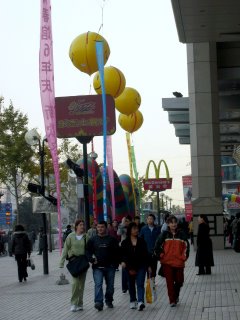





What do I eat at home? Well, for breakfast I have eggs, Post raisin bran or oatmeal. If I'm here for lunch, I have a ham or turkey sandwich or peanut butter and jelly. I finally found a super market with western style meats. I purchased chicken breast and steak and I have cooked them at home. I've also made soup which I enjoy for supper. Occasionally I have pasta but usually I have enough leftovers from restaurants to heat up so I don't have to cook very often. Fresh vegetables are somewhat limited here. I don't have an oven, so everything I make has to made on the stove top. There is a nice restaurant on the YMCA premises where I eat about once a week. Usually, I have noodles and vegetables in soup but this week I had beef with peppers which was very nicely prepared. I've been able to get chocolate bars and imported cookies in the foreign section of the supermarket. They even have skim milk and a low fat cheese which I enjoy once in a while. There's a 7 - 11 nearby which has Chips Ahoy. I don't buy these because if I did I would probably eat the whole bag at one sitting. They also have the best wine buy. Wine is very expensive and not very good. I've found a Chilean wine which is passable and costs about $8 per bottle. But still, compared to California the quality is not as good and the cost is pretty high. Where's Trader Joe's when you need it!
There are some other eateries you might recognize but I haven't resorted to them yet. However, there's a walk up window at McDonalds and I always see the locals lining up on the sidewalk for their Big Mac's!



Saturday, November 11, 2006
Field Trip
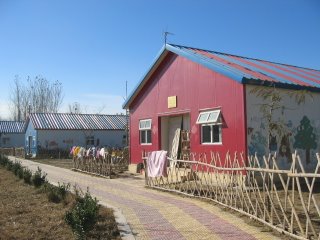 On Tuesday, November 7th, I was invited by Mr. Cai, the General Secretary, to take a trip to the countryside to visit some YMCA sponsored programs. We were accompanied by Mr. Song and Zhu Qi, the Executive Secretary. Zhu Qi arranges many international visits for the YMCA. The first place we visited was called Sunshine Village in Pingu located about 150 kilometers east of Beijing. Sunshine Village was founded by a retired woman who saw a need for the children of convicted criminals to have a home. Many of these parents are sent away for about 15 years, so it is the whole time a child is growing up. When they are released, this organization provides some rehabilitation and counseling to the parents before they are reunited with their children. Without this village, these children would be homeless or worse. The village is supported by many groups and countries. I saw a sign for the Rotary and one dormitory is supported by a German group, another by the Hong Kong YMCA. They serve about 80 children. During our visit, we saw some dormitories, the pre-school area, the cafeteria, the coal burning boiler and the vegetable gardens. There were several piles of coal around the premises. I haven't seen a pile of coal since I was a young kid in the 1950s. My aunt and uncle used coal for fuel since they hadn't yet converted to oil and we kids used to slide around the coal pile. While we were there, a high school group from Sweden were also visiting and some folks from England were donating clothing and toys.
On Tuesday, November 7th, I was invited by Mr. Cai, the General Secretary, to take a trip to the countryside to visit some YMCA sponsored programs. We were accompanied by Mr. Song and Zhu Qi, the Executive Secretary. Zhu Qi arranges many international visits for the YMCA. The first place we visited was called Sunshine Village in Pingu located about 150 kilometers east of Beijing. Sunshine Village was founded by a retired woman who saw a need for the children of convicted criminals to have a home. Many of these parents are sent away for about 15 years, so it is the whole time a child is growing up. When they are released, this organization provides some rehabilitation and counseling to the parents before they are reunited with their children. Without this village, these children would be homeless or worse. The village is supported by many groups and countries. I saw a sign for the Rotary and one dormitory is supported by a German group, another by the Hong Kong YMCA. They serve about 80 children. During our visit, we saw some dormitories, the pre-school area, the cafeteria, the coal burning boiler and the vegetable gardens. There were several piles of coal around the premises. I haven't seen a pile of coal since I was a young kid in the 1950s. My aunt and uncle used coal for fuel since they hadn't yet converted to oil and we kids used to slide around the coal pile. While we were there, a high school group from Sweden were also visiting and some folks from England were donating clothing and toys.

 .
.
 After this visit we stopped at some fields full of fruit trees. I'm told they are date trees but the they looked more like fig trees. However, the fruit does look like dates. I didn't get to taste it since it was already past harvest. Apparently these trees are sponsored by people who pay about 50 RMB per year ($6.25) and the proceeds from the sale of the fruit go to help support the local school. This is a poor, rural area. We also picked up a local vegetable which grows in between the trees. It looks like a turnip but tastes more like a mild radish. Very good.
After this visit we stopped at some fields full of fruit trees. I'm told they are date trees but the they looked more like fig trees. However, the fruit does look like dates. I didn't get to taste it since it was already past harvest. Apparently these trees are sponsored by people who pay about 50 RMB per year ($6.25) and the proceeds from the sale of the fruit go to help support the local school. This is a poor, rural area. We also picked up a local vegetable which grows in between the trees. It looks like a turnip but tastes more like a mild radish. Very good. By this time we had worked up an appetite. We stopped at a local restaurant. For the city people, this is a treat. Much like when we visit the countryside and have local farm fresh food. We had a kind of cabbage soup, vegetables, dumplings with egg and meat fillings, pork sausage and a favorite of my companions, donkey. I tried some and it wasn't half bad. It looked like pot roast and, indeed, it had been marinated and cooked the same way we would cook pot roast. However, it was served cold with a soy sauce mixture for dipping. The soup is my favorite. I'd had several variations of it before. It tastes something like a mild sauerkraut in a mild broth and can really warm up the tummy on a chilly day!
By this time we had worked up an appetite. We stopped at a local restaurant. For the city people, this is a treat. Much like when we visit the countryside and have local farm fresh food. We had a kind of cabbage soup, vegetables, dumplings with egg and meat fillings, pork sausage and a favorite of my companions, donkey. I tried some and it wasn't half bad. It looked like pot roast and, indeed, it had been marinated and cooked the same way we would cook pot roast. However, it was served cold with a soy sauce mixture for dipping. The soup is my favorite. I'd had several variations of it before. It tastes something like a mild sauerkraut in a mild broth and can really warm up the tummy on a chilly day! Next, it was on to another, even smaller, rural village about 40 kilometers north of Pingu. The purpose was to visit an elementary school sponsored by the Tokyo YMCA. The school is in a compound and serves about 120 students. We met the headmaster and the magistrate of the village. We spent some time visiting the kindergarten children and peeking in at a classroom. The children are also learning English in school. I can't speak enough about the hospitality of the people in China everywhere I go. You truly feel like an honored guest!
Next, it was on to another, even smaller, rural village about 40 kilometers north of Pingu. The purpose was to visit an elementary school sponsored by the Tokyo YMCA. The school is in a compound and serves about 120 students. We met the headmaster and the magistrate of the village. We spent some time visiting the kindergarten children and peeking in at a classroom. The children are also learning English in school. I can't speak enough about the hospitality of the people in China everywhere I go. You truly feel like an honored guest!

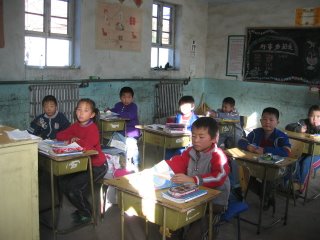
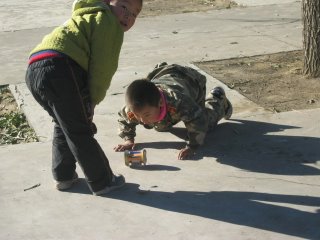
Monday, November 06, 2006
October Tours
After about one and a half weeks here, the weather turned magnificent with sunny, clear days and temperatures in the low 70s and high 60s. Perfect for taking walking tours in and around Beijing. Now I will try to share with you some of the tours I've taken either on my own or with a group.
Sunday, November 5th, Peking Man Site and Marco Polo Bridge


This was a Chinese Culture Club (CCC) tour to the UNESCO-listed site of the caves where the first group of Beijing people lived from about 500,000 to 125,000 years ago, and the museum of Peking Man Site. Many fossils were found here including four skulls which were lost in the 1930s during transit. However, there are other fragments and evidence that the Peking Men knew how to build and use fire.
Then we drove to the Marco Polo Bridge, built in 1192, and saw the marvelous carvings of lions on the bridge as well as the bullet holes from the bloody Sino-Japanese war still embedded in the walls of the nearby town, Wanping. The bridge is called Marco Polo because when he visited it he was very impressed with it. You can still see part of the old road worn deep with ruts from wagons passing over it over the last 900 years. There are about 500 carved lions and each is unique. It is also built on beautiful arches but I couldn't get a good picture of them. The bridge is now over a dry river bed. It leads into the city gate of Wanping.
The old walled town of Wanping was charming and we had a nice quiet walk through the town. There were no other tourists there. Another nice thing is that there is no commercialism in these towns. One would be hard pressed to find any kind of souvenir, just local merchants selling to local townspeople. It was also a respite from the crowds and noise of Beijing.
>

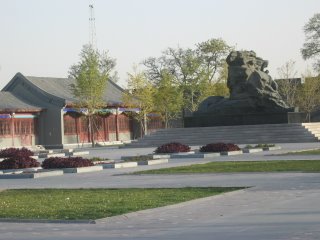
Tuesday, October 31, Red Leaves at Fragrant Hills Park
 This was a major disappointment. Crowded, noisy and over commericalized. One of the few places I've been to like that. Luckily I hooked up with a woman from New York city. We had a lot to talk about and it saved the day! We rode the chair lift up the mountain (the others had elected to hike up and down another part of the mountain), took a couple of pictures, got shoved around by other tourists, had a bit of lunch which we had packed and turned aroung to take the chair lift down. It turned out we had to wait on line for one hour and we were a half hour late for the bus. Not the way to be the most popular in the group!
This was a major disappointment. Crowded, noisy and over commericalized. One of the few places I've been to like that. Luckily I hooked up with a woman from New York city. We had a lot to talk about and it saved the day! We rode the chair lift up the mountain (the others had elected to hike up and down another part of the mountain), took a couple of pictures, got shoved around by other tourists, had a bit of lunch which we had packed and turned aroung to take the chair lift down. It turned out we had to wait on line for one hour and we were a half hour late for the bus. Not the way to be the most popular in the group!
Sunday, October 29 Cock Crow Post Town
 This was by far the best trip I've had. We were a small group of about 16 and had the whole town to ourselves. We had a private guided tour with a local woman taking us into temples, courtyard houses and the local school. Lunch was freshly cooked by the locals and was refreshing and delicious. I am including a description from the World Monument Fund.
This was by far the best trip I've had. We were a small group of about 16 and had the whole town to ourselves. We had a private guided tour with a local woman taking us into temples, courtyard houses and the local school. Lunch was freshly cooked by the locals and was refreshing and delicious. I am including a description from the World Monument Fund.
Cockcrow Post Town (Ji Ming Yi or Station of Rooster Crows) was recently listed for the second time by World Monuments Fund (WMF) in the 2006 World Monuments Watch List of world 100 most endangered sites. (It was firstly listed by WMF in 2004). The Ming-period Cockcrow Postal Town (Ji Ming Yi), located at Huailai County, Zhangjiakou, Hebei Province, approximately 145 kilometers northwest of Beijing, is the largest postal town of its kind in China, and the only surviving example of its era.
Ji Ming Yi was a major post office and an important location for travelers and workers alike to change horses and pass on transport duties between Beijing and western areas of China and beyond; as a result for some time this small village prospered. Dowager Empress Cixi stayed here one night as she fled the invading forces attacking Beijing.
The largest town on the former postal road between Beijing and Datong, Cockcrow was constructed in 1420 to protect the military and public post stations that served the northwest region of the Chinese empire. Although the town suffered during the Cultural Revolution, locals managed to preserve a number of aristocratic houses as well as carvings and wall paintings within temples by covering them with mudplaster and newspaper.
Cockcrow (Ji Ming Yi) is still inhabited with temples, offices, schools, and a wealth of courtyard houses, all surrounded by a massive rammed-earth-and-masonry town wall. The brick surfaces of the town wall have begun to decay, exposing their clay inner structure to damaging rains. Seven out of 17 remaining original temples in the town are in danger of being lost. To date, the government has provided little funding and few solutions to these problems. The Hebei Province Institute of Urban Planning in conjunction with Tsinghua University has developed a masterplan for the site, which would include removing plaster from murals and carvings as well as several major pilot restoration projects. Despite Cockcrows listing in 2004, financial resources are not yet available to implement the conservation plan, and the inhabitants of the town are steadily leaving the area as the physical deterioration of the town accelerates.(Above is the description from the web page of the World Monument Fund).
Saturday, October 28 Royal Canal Tour



This was a half day trip on the Royal Canal route to the Summer Palace. On the way we stopped at some temples that are off the beaten track for most tourists and at the Purple Bamboo Forest where we saw locals practicing martial arts and gathering together for a group sing a long. Beautiful day.
Thursday, October 26 Art Tour
 Here is the description CCC gives of this tour: The tour start from visiting the porcelain exhibition in the Forbidden City, you will see typical porcelain wares in different dynasties from various kilns. Then transfer to Beijing Art Academy for traditional masterpieces of Ink & Water Painting, then finish the tour at 798 art zone, which are the loft style studios and galleries featuring contemporary Chinese art. You will have a rest in the middle at lunch table, savor and learn the knowledge of Chinese food, cooking materials & condiments and skills.
Here is the description CCC gives of this tour: The tour start from visiting the porcelain exhibition in the Forbidden City, you will see typical porcelain wares in different dynasties from various kilns. Then transfer to Beijing Art Academy for traditional masterpieces of Ink & Water Painting, then finish the tour at 798 art zone, which are the loft style studios and galleries featuring contemporary Chinese art. You will have a rest in the middle at lunch table, savor and learn the knowledge of Chinese food, cooking materials & condiments and skills.
However, it was more than the description. We took a lovely walk in the Forbidden City, through some of the back alleys often off limits to tourists. The art zone was a great surprise and very enjoyable to see. One could take a full day here and not see everything. Lunch was lavish and fabulous, giving us ex-pats a chance to get to know each other better.
Wednesday, October 25 Temple of Heaven
 This is a tour I took on my own using an audio guide. It is quite near my apartment. Again, it was a beautiful day and the site itself is quite amazing, despite the plethora of tourists, mostly Chinese. It is south of the Forbidden City and is where the emperor would go to pray for a good harvest. It was not overly crowded, however so the day was quite pleasant. If I get a good weather day, I may go back again to see some of the things I missed on my first visit.
This is a tour I took on my own using an audio guide. It is quite near my apartment. Again, it was a beautiful day and the site itself is quite amazing, despite the plethora of tourists, mostly Chinese. It is south of the Forbidden City and is where the emperor would go to pray for a good harvest. It was not overly crowded, however so the day was quite pleasant. If I get a good weather day, I may go back again to see some of the things I missed on my first visit.
Sunday, October 22 Sunday in the Park
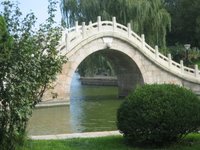 This was my first Sunday where the weather was nice and I was completely on my own. I went to a local park and was surprised to find how beautiful and peaceful it was right in the middle of the city. No cars or bicycles, just local people taking a stroll and enjoying the beautiful weather and scenery. Just what I needed for my soul! On my walk,I met a lovely young couple who greeted me in English. They both spoke English and we strolled around together learning about each other. Their goal is to pass the English test and go to university in Australia.
This was my first Sunday where the weather was nice and I was completely on my own. I went to a local park and was surprised to find how beautiful and peaceful it was right in the middle of the city. No cars or bicycles, just local people taking a stroll and enjoying the beautiful weather and scenery. Just what I needed for my soul! On my walk,I met a lovely young couple who greeted me in English. They both spoke English and we strolled around together learning about each other. Their goal is to pass the English test and go to university in Australia.
Friday, October 20 Back Street Beijing


 On this tour we saw the White Pagoda Temple, strolled through a hutong (an alley with couryard houses). They are fast disappearing in Beijing, being razed for new development and with them goes a way of life that has been around for centuries. Notice the barber pole in the picture. The houses have electricty but most share a public toilet as they do not have indoor plumbing. The public toilets are pretty modern but are of the squat kind. We also visited a pet market. The pets were the typical dogs, cats and rabbits. Also, crickets in cages, scorpians and other creepy crawly things and plenty of worms and maggots to feed them. Here you can see turtles and snails.
On this tour we saw the White Pagoda Temple, strolled through a hutong (an alley with couryard houses). They are fast disappearing in Beijing, being razed for new development and with them goes a way of life that has been around for centuries. Notice the barber pole in the picture. The houses have electricty but most share a public toilet as they do not have indoor plumbing. The public toilets are pretty modern but are of the squat kind. We also visited a pet market. The pets were the typical dogs, cats and rabbits. Also, crickets in cages, scorpians and other creepy crawly things and plenty of worms and maggots to feed them. Here you can see turtles and snails.
Wednesday, October 18 Shopping

On this day, one of the Y staff, Laura, and I went shopping to find some things to hang on the walls of my apartment which is quite bare. We walked through some shopping alleys, near Tiananmen Square, much frequented by the locals and, thanks to Laura, we succeeded in bargaining a good price for some cheery wall hangings to liven up the place. Had delicious dumplings for lunch and wheat soup similar to farina.
Monday, October 16 The Great Wall
I've written about this in a previous update.
Now that the cold weather has arrived, I don't expect to have as many tours packed in to such a small window of time. Most likely, I will visit indoor venues and explore some shopping areas.
Sunday, November 5th, Peking Man Site and Marco Polo Bridge



This was a Chinese Culture Club (CCC) tour to the UNESCO-listed site of the caves where the first group of Beijing people lived from about 500,000 to 125,000 years ago, and the museum of Peking Man Site. Many fossils were found here including four skulls which were lost in the 1930s during transit. However, there are other fragments and evidence that the Peking Men knew how to build and use fire.
Then we drove to the Marco Polo Bridge, built in 1192, and saw the marvelous carvings of lions on the bridge as well as the bullet holes from the bloody Sino-Japanese war still embedded in the walls of the nearby town, Wanping. The bridge is called Marco Polo because when he visited it he was very impressed with it. You can still see part of the old road worn deep with ruts from wagons passing over it over the last 900 years. There are about 500 carved lions and each is unique. It is also built on beautiful arches but I couldn't get a good picture of them. The bridge is now over a dry river bed. It leads into the city gate of Wanping.
The old walled town of Wanping was charming and we had a nice quiet walk through the town. There were no other tourists there. Another nice thing is that there is no commercialism in these towns. One would be hard pressed to find any kind of souvenir, just local merchants selling to local townspeople. It was also a respite from the crowds and noise of Beijing.
>



Tuesday, October 31, Red Leaves at Fragrant Hills Park
 This was a major disappointment. Crowded, noisy and over commericalized. One of the few places I've been to like that. Luckily I hooked up with a woman from New York city. We had a lot to talk about and it saved the day! We rode the chair lift up the mountain (the others had elected to hike up and down another part of the mountain), took a couple of pictures, got shoved around by other tourists, had a bit of lunch which we had packed and turned aroung to take the chair lift down. It turned out we had to wait on line for one hour and we were a half hour late for the bus. Not the way to be the most popular in the group!
This was a major disappointment. Crowded, noisy and over commericalized. One of the few places I've been to like that. Luckily I hooked up with a woman from New York city. We had a lot to talk about and it saved the day! We rode the chair lift up the mountain (the others had elected to hike up and down another part of the mountain), took a couple of pictures, got shoved around by other tourists, had a bit of lunch which we had packed and turned aroung to take the chair lift down. It turned out we had to wait on line for one hour and we were a half hour late for the bus. Not the way to be the most popular in the group!Sunday, October 29 Cock Crow Post Town
 This was by far the best trip I've had. We were a small group of about 16 and had the whole town to ourselves. We had a private guided tour with a local woman taking us into temples, courtyard houses and the local school. Lunch was freshly cooked by the locals and was refreshing and delicious. I am including a description from the World Monument Fund.
This was by far the best trip I've had. We were a small group of about 16 and had the whole town to ourselves. We had a private guided tour with a local woman taking us into temples, courtyard houses and the local school. Lunch was freshly cooked by the locals and was refreshing and delicious. I am including a description from the World Monument Fund.Cockcrow Post Town (Ji Ming Yi or Station of Rooster Crows) was recently listed for the second time by World Monuments Fund (WMF) in the 2006 World Monuments Watch List of world 100 most endangered sites. (It was firstly listed by WMF in 2004). The Ming-period Cockcrow Postal Town (Ji Ming Yi), located at Huailai County, Zhangjiakou, Hebei Province, approximately 145 kilometers northwest of Beijing, is the largest postal town of its kind in China, and the only surviving example of its era.
Ji Ming Yi was a major post office and an important location for travelers and workers alike to change horses and pass on transport duties between Beijing and western areas of China and beyond; as a result for some time this small village prospered. Dowager Empress Cixi stayed here one night as she fled the invading forces attacking Beijing.

The largest town on the former postal road between Beijing and Datong, Cockcrow was constructed in 1420 to protect the military and public post stations that served the northwest region of the Chinese empire. Although the town suffered during the Cultural Revolution, locals managed to preserve a number of aristocratic houses as well as carvings and wall paintings within temples by covering them with mudplaster and newspaper.
Cockcrow (Ji Ming Yi) is still inhabited with temples, offices, schools, and a wealth of courtyard houses, all surrounded by a massive rammed-earth-and-masonry town wall. The brick surfaces of the town wall have begun to decay, exposing their clay inner structure to damaging rains. Seven out of 17 remaining original temples in the town are in danger of being lost. To date, the government has provided little funding and few solutions to these problems. The Hebei Province Institute of Urban Planning in conjunction with Tsinghua University has developed a masterplan for the site, which would include removing plaster from murals and carvings as well as several major pilot restoration projects. Despite Cockcrows listing in 2004, financial resources are not yet available to implement the conservation plan, and the inhabitants of the town are steadily leaving the area as the physical deterioration of the town accelerates.(Above is the description from the web page of the World Monument Fund).
Saturday, October 28 Royal Canal Tour




This was a half day trip on the Royal Canal route to the Summer Palace. On the way we stopped at some temples that are off the beaten track for most tourists and at the Purple Bamboo Forest where we saw locals practicing martial arts and gathering together for a group sing a long. Beautiful day.
Thursday, October 26 Art Tour
 Here is the description CCC gives of this tour: The tour start from visiting the porcelain exhibition in the Forbidden City, you will see typical porcelain wares in different dynasties from various kilns. Then transfer to Beijing Art Academy for traditional masterpieces of Ink & Water Painting, then finish the tour at 798 art zone, which are the loft style studios and galleries featuring contemporary Chinese art. You will have a rest in the middle at lunch table, savor and learn the knowledge of Chinese food, cooking materials & condiments and skills.
Here is the description CCC gives of this tour: The tour start from visiting the porcelain exhibition in the Forbidden City, you will see typical porcelain wares in different dynasties from various kilns. Then transfer to Beijing Art Academy for traditional masterpieces of Ink & Water Painting, then finish the tour at 798 art zone, which are the loft style studios and galleries featuring contemporary Chinese art. You will have a rest in the middle at lunch table, savor and learn the knowledge of Chinese food, cooking materials & condiments and skills.
However, it was more than the description. We took a lovely walk in the Forbidden City, through some of the back alleys often off limits to tourists. The art zone was a great surprise and very enjoyable to see. One could take a full day here and not see everything. Lunch was lavish and fabulous, giving us ex-pats a chance to get to know each other better.
Wednesday, October 25 Temple of Heaven
 This is a tour I took on my own using an audio guide. It is quite near my apartment. Again, it was a beautiful day and the site itself is quite amazing, despite the plethora of tourists, mostly Chinese. It is south of the Forbidden City and is where the emperor would go to pray for a good harvest. It was not overly crowded, however so the day was quite pleasant. If I get a good weather day, I may go back again to see some of the things I missed on my first visit.
This is a tour I took on my own using an audio guide. It is quite near my apartment. Again, it was a beautiful day and the site itself is quite amazing, despite the plethora of tourists, mostly Chinese. It is south of the Forbidden City and is where the emperor would go to pray for a good harvest. It was not overly crowded, however so the day was quite pleasant. If I get a good weather day, I may go back again to see some of the things I missed on my first visit. Sunday, October 22 Sunday in the Park
 This was my first Sunday where the weather was nice and I was completely on my own. I went to a local park and was surprised to find how beautiful and peaceful it was right in the middle of the city. No cars or bicycles, just local people taking a stroll and enjoying the beautiful weather and scenery. Just what I needed for my soul! On my walk,I met a lovely young couple who greeted me in English. They both spoke English and we strolled around together learning about each other. Their goal is to pass the English test and go to university in Australia.
This was my first Sunday where the weather was nice and I was completely on my own. I went to a local park and was surprised to find how beautiful and peaceful it was right in the middle of the city. No cars or bicycles, just local people taking a stroll and enjoying the beautiful weather and scenery. Just what I needed for my soul! On my walk,I met a lovely young couple who greeted me in English. They both spoke English and we strolled around together learning about each other. Their goal is to pass the English test and go to university in Australia.Friday, October 20 Back Street Beijing


 On this tour we saw the White Pagoda Temple, strolled through a hutong (an alley with couryard houses). They are fast disappearing in Beijing, being razed for new development and with them goes a way of life that has been around for centuries. Notice the barber pole in the picture. The houses have electricty but most share a public toilet as they do not have indoor plumbing. The public toilets are pretty modern but are of the squat kind. We also visited a pet market. The pets were the typical dogs, cats and rabbits. Also, crickets in cages, scorpians and other creepy crawly things and plenty of worms and maggots to feed them. Here you can see turtles and snails.
On this tour we saw the White Pagoda Temple, strolled through a hutong (an alley with couryard houses). They are fast disappearing in Beijing, being razed for new development and with them goes a way of life that has been around for centuries. Notice the barber pole in the picture. The houses have electricty but most share a public toilet as they do not have indoor plumbing. The public toilets are pretty modern but are of the squat kind. We also visited a pet market. The pets were the typical dogs, cats and rabbits. Also, crickets in cages, scorpians and other creepy crawly things and plenty of worms and maggots to feed them. Here you can see turtles and snails.Wednesday, October 18 Shopping

On this day, one of the Y staff, Laura, and I went shopping to find some things to hang on the walls of my apartment which is quite bare. We walked through some shopping alleys, near Tiananmen Square, much frequented by the locals and, thanks to Laura, we succeeded in bargaining a good price for some cheery wall hangings to liven up the place. Had delicious dumplings for lunch and wheat soup similar to farina.
Monday, October 16 The Great Wall
I've written about this in a previous update.
Now that the cold weather has arrived, I don't expect to have as many tours packed in to such a small window of time. Most likely, I will visit indoor venues and explore some shopping areas.
Subscribe to:
Posts (Atom)